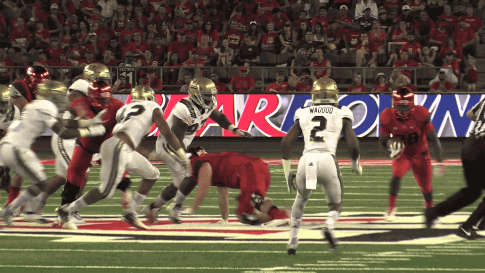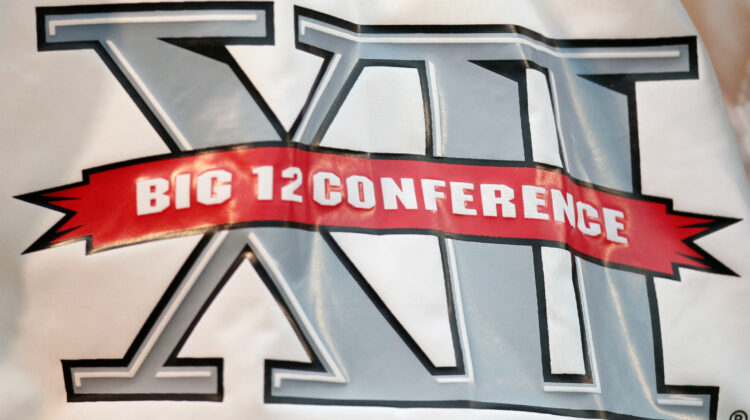The Big 12 revealed the first football schedule of its sprawling next chapter on Tuesday. And like so much about the conference, the 2024 lineup is heavy on balance.
Some paths are easier than others, but the differences are mostly on the margins.
Before we dive into the weekly schedules for the Arizona schools, Utah, Brigham Young and Colorado, a few reminders of the broader framework:
— The Big 12 will play nine conference games with no divisions next season.
— None of the Pacific/Mountain Time Zone teams will make more than one trip to the Big 12’s eastern wing.
— Two games matching Big 12 teams (Arizona vs. Kansas State and Utah vs. Baylor) will be classified as non-conference affairs because of pre-existing contracts.
— Kickoff times will be announced later this year.
Here we go …
Arizona
The good: The Wildcats don’t play Oklahoma State or Kansas — both figure to be title contenders — and the back half of the schedule is wholly manageable, with four home games and a bye to recharge for what could be a title drive. Oh, and there’s this: They have a week off before visiting Utah, whereas the Utes head to Oklahoma State the Saturday prior to Arizona’s arrival.
The bad: Everything hinges on the first half of the season, a potentially precarious situation given the new coaching staff and a brutal collection of road trips to Kansas State, Utah and Brigham Young. But if Arizona gets to the middle of October within sight of first place, watch out.
Tipping point: Arizona’s best chance to generate momentum is smack in the middle of the schedule, Weeks 8 and 9, when Colorado and West Virginia visit Tucson. With two wins, the Wildcats would be positioned for a meaningful stretch run.
Beware the trap: Nov. 2 at UCF. Arizona’s only cross-country trip comes at a key juncture, after the home dates mentioned above and before the stretch run. The Knights were 3-6 in conference play last season and won’t be circled on any Arizona calendars.
Overall assessment: Other than the early trips to both Salt Lake City and Provo, the Wildcats couldn’t have scripted a better lineup to support what they hope will be a run to the Big 12 championship game.
Arizona State
The good: There isn’t much, folks. ASU’s schedule is one of the toughest in the conference. The Sun Devils host both Utah and BYU, which will help sell tickets. But that’s the extent of the favorable elements.
The bad: Where should we begin? How about with the overall lineup of opponents: Arizona, BYU, Utah, Kansas, Kansas State, Oklahoma State — they are all on the schedule. In other words, ASU misses many of the teams that seemingly present the best opportunities for success. And the stretch run, with trips to Stillwater, Manhattan and Tucson, is brutal.
Tipping point: To the extent second-year coach Kenny Dillingham will possess a roster capable of contending for a bowl bid, the key stretch comes in September with Wyoming and Mississippi State at home and Texas State and Texas Tech on the road. ASU must emerge from the opening month with three wins, or the postseason path will be treacherous.
Beware the trap: Nov. 9 vs. UCF. Between road games against Oklahoma State and Kansas State, which could very well be ranked at the time of kickoff, the Sun Devils host the Knights. We can envision a low-energy environment in the stadium as ASU struggles to muster the urgency required to handle its business.
Overall assessment: ASU’s overall outlook remains murky as the school waits for a ruling from the NCAA and Dillingham works to rebuild his roster. But the program’s difficult Big 12 schedule won’t help matters and just might slow progress.
Brigham Young
The good: September is entirely manageable with Southern Illinois, Wyoming and SMU as the non-conference affairs, plus Kansas State at home and a trip to Baylor (3-9 last season). And generally, the Cougars play most of their toughest games in Provo. Lastly, the byes for BYU and Utah before the Holy War should lead to a high level of play in the rivals’ first conference affair since 2010.
The bad: Like Arizona State, the Cougars will face a barrage of title contenders and likely bowl teams, including Utah, Arizona, Oklahoma State and the Kansas schools. (Of note: The Cowboys will be coming off a bye when they visit BYU.) Also, the second half is vastly more difficult than the first. If BYU doesn’t rack up wins early, results might not matter late.
Tipping point: It’s all about the middle weeks of the season’s middle month: The daunting back-to-back visits by Arizona and Oklahoma State. If the Cougars get swept, their prospects for a meaningful stretch run will turn bleak.
Beware the trap: Nov. 16 vs. Kansas. Home dates against teams coming off nine-win seasons don’t typically qualify as traps. But the Jayhawks will touch down in Provo a week after BYU drives home from Salt Lake City. Win or lose the Holy War, the Cougars will be vulnerable to a detour through Letdown City.
Overall assessment: BYU is the only continuing member of the Big 12 that gains a rival in the wake of Texas and Oklahoma leaving the conference. But the Holy War is merely one component of a difficult schedule that will make progress slow in Year 2.
Colorado
The good: There is ample chance for early momentum as the Buffs open conference action with Baylor at home and UCF on the road. Then comes a bye, followed by Kansas State’s visit to Boulder. All in all, it’s not unreasonable to sketch a 3-0 start for CU in Big 12 play.
The bad: The non-conference schedule is challenging (Nebraska, Colorado State and perennial FCS power North Dakota State). And in our view, the Buffaloes need to win six of their first nine because the finish — Utah and Oklahoma State at home, Kansas on the road — carries the distinct scent of 0-3.
Tipping point: We’ll know the Buffs’ trajectory before the midpoint of September, for they must win at least two non-conference games to have a reasonable chance of bowl eligibility. Put another way: The path to a 4-5 record in Big 12 play is much, much easier than the road to 5-4.
Beware the trap: Sept. 21 vs. Baylor. Colorado’s first Big 12 game in 14 years nevertheless looks like a trap to the Hotline given its spot in the schedule — after the back-to-back against Nebraska and Colorado State — and considering Baylor’s (likely) unranked status.
Overall assessment: A few subtle location changes could have made CU’s return to its longtime home vastly more difficult. It hardly qualifies as easy, but we don’t see a lineup daunting enough to prevent the Buffs from bowling as long as they remain reasonably healthy and perform better on the line of scrimmage.
Utah
The good: If the Utes are within range of first place in the middle of October, they should be ideally positioned for a berth in the Big 12 championship. The back half of the schedule isn’t merely manageable, it’s darn close to soft. That’s particularly true of the very finish: Utah concludes the season with Iowa State at home and UCF on the road.
The bad: Just as the finish is favorable, the start is stout. The Utes open conference play with one of the most impactful games of the season — at Oklahoma State — then must regroup quickly for a home date with Arizona, which should be well rested following a bye.
Tipping point: The final Saturdays of September will frame the rest of the season. If the Utes sweep Oklahoma State and Arizona, they won’t be caught. The race becomes a mad scramble for second.
Beware the trap: Oct. 26 at Houston. Our sketch of Utah’s season includes mid-season beatdowns of Arizona State (road) and TCU (home). At that point, the Utes would carry a gaudy record to Houston with one eye on the upcoming Holy War. A vulnerable spot, it seems.
Overall assessment: How nice of the Big 12 to allow Kyle Whittingham to hand-craft Utah’s schedule for its debut season. (We’re joking, of course, but the lineup is indisputably favorable, especially in its combination of road games.)
*** Send suggestions, comments and tips (confidentiality guaranteed) to pac12hotline@bayareanewsgroup.
*** Follow me on Twitter/X: @WilnerHotline
*** Pac-12 Hotline is not endorsed or sponsored by the Pac-12 Conference, and the views expressed herein do not necessarily reflect the views of the Conference.
Related posts:
 ASU, UofA still have NCAA tournament goals in the Palm of their hands
ASU, UofA still have NCAA tournament goals in the Palm of their hands
 GIF-Wrapped Takeaways: Spring Ball Edition
GIF-Wrapped Takeaways: Spring Ball Edition

(AP Photo/Rick Scuteri)
Selection Sunday Coming Up Fast, Pac-12 Net Rankings
(AP Photo/Ralph Freso, File)
Hotline Mailbag – Breaking down Utah-Florida and Oregon-Georgia, Shaw’s job security and more

